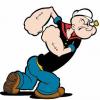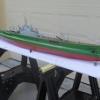MORE HANDBOOKS ARE ON THEIR WAY! We will let you know when they get here.
×
-
Posts
1,368 -
Joined
-
Last visited
Reputation Activity
-
 FriedClams reacted to lmagna in Zebulon B Vance by ESF - FINISHED - Dean's Marine - 1:96 - PLASTIC - RADIO
FriedClams reacted to lmagna in Zebulon B Vance by ESF - FINISHED - Dean's Marine - 1:96 - PLASTIC - RADIO
What you my discover Steve, is that an RC ship is NEVER finished! Any and all weak areas will soon make themselves apparent, some possibly more than once! You will have plenty of opportunity to do things different.
Or possibly I'm just a lousy builder and navigator and it was just my ships that needed constant updates, improvements, and repairs.
-
 FriedClams reacted to ESF in Zebulon B Vance by ESF - FINISHED - Dean's Marine - 1:96 - PLASTIC - RADIO
FriedClams reacted to ESF in Zebulon B Vance by ESF - FINISHED - Dean's Marine - 1:96 - PLASTIC - RADIO
To those who gave likes, thank you and thanks for stopping by.
Steve
Door swing redux.
Here’s the railing fix so the door can swing open and not stay bolted all the time. The painters are off for the weekend and will patch up the old railing hole next week. I know, it's probably still a little tight but I needed room to return the railing to the wall, and they can tie the door off to the railing if they need to.
I knew part of the railing would conflict with the ship’s ladder between the bridge and top decks so I folded up the ladder, test fit it and trimmed where needed.
While getting out the ladder pieces I noticed the three steps to the compass platform which were folded up and painted awhile ago. I hadn’t put them in place since the glue surface to the platform side is minuscule and I hadn’t figured out the railing. I decided I better do it before I lost the steps. This is the second try at the railing - after installing the first try something seemed odd and then I realized the railings were so high they would be in someone’s armpits, or hitting them in the side of the head if they were vertically challenged. Since the railings are anchored into the side of the platform they provide some support to the lower part of step stringers. Next time I'll leave the tails of the top platform railings long to make a nicer transition into the stair rails. Learning, learning, learning.
-
 FriedClams reacted to GrandpaPhil in Genesis by Omega1234 - FINISHED - 1/300 - 49 m Mega Yacht
FriedClams reacted to GrandpaPhil in Genesis by Omega1234 - FINISHED - 1/300 - 49 m Mega Yacht
Have at it! I’m looking forward to the build log!
-
 FriedClams reacted to Omega1234 in Genesis by Omega1234 - FINISHED - 1/300 - 49 m Mega Yacht
FriedClams reacted to Omega1234 in Genesis by Omega1234 - FINISHED - 1/300 - 49 m Mega Yacht
Thanks Denis!
Actually...I’m pretty sure than this one will be my next challenge: https://www.yachtcharterfleet.com/luxury-charter-yacht-43054/okto-yacht-charter-printable.pdf.
What do you think?
Cheers
Patrick
-
 FriedClams reacted to druxey in Kathryn by Mahuna - FINISHED - 1:32 - Skipjack Based on HAER Drawings
FriedClams reacted to druxey in Kathryn by Mahuna - FINISHED - 1:32 - Skipjack Based on HAER Drawings
That's a very useful 'how to', Frank. Steel wire is a beast to work with!
-
 FriedClams reacted to Mahuna in Kathryn by Mahuna - FINISHED - 1:32 - Skipjack Based on HAER Drawings
FriedClams reacted to Mahuna in Kathryn by Mahuna - FINISHED - 1:32 - Skipjack Based on HAER Drawings
Part 88 –Shrouds cont’d
After my last post I was moving Kathryn and saw that the forward port shroud moved a lot, and it proved to be too loose. Looking at it while the model was static, it looked ‘good enough’. However, we all frequently find that ‘good enough’ really isn’t good enough – so it needed to be corrected.
On a model with rope shrouds, this normally means that the lanyard for the offending shroud just needs to be tightened a little more. In Kathryn’s case, however, the crimping beads couldn’t be ‘uncrimped’, so both port shrouds needed to be cut away and replaced. Since I hadn’t taken many photos of the shroud installation for the previous post I took this opportunity to record the steps.
The first step was to cut away the existing shroud at the crimping beads, first at the turnbuckles and then at the hounds.
The discarded shroud joined the others from the ‘trial and error’ phase.
Before installing the new shroud, I decided to install the upper blocks for the jib halyard and the jib sheet, since it would be easier to do than when the shrouds were in place.
The new shroud was pre-bent where it would wrap around the mast, using a mandrel marked at the appropriate diameter.
The shroud was positioned at the mast hounds using an alligator clip to keep the shroud from springing open and losing the crimping bead.
The alligator clip was used to push the crimping bead in place while adjusting the shroud leads, and then was used to hold the bead in place while it was crimped.
The shrouds needed to be clamped to the mast at or below the hounds. The wire used for the shrouds tends to spring away from the mast, and should be held in place against the mast while installing the shrouds. After installation the spring-back would serve to tighten the shroud.
The shroud was run through the shackle it would be attached to, and a small clip was used to keep track of exactly where the wire needed to be bent.
After the wire was bent the crimping bead was added to the wire and a small clip was used to keep the bead from sliding off the wire,
and another clip was used to keep the turnbuckle from falling off the wire.
When all elements were in place the shroud was crimped at the turnbuckle. This process was then followed for the forward shroud (being left-handed, it was easier to work on the aft port shroud before the forward one).
Both port shrouds are now tight and stable.
Now we can start focusing on the jib.
-
 FriedClams reacted to druxey in Kathryn by Mahuna - FINISHED - 1:32 - Skipjack Based on HAER Drawings
FriedClams reacted to druxey in Kathryn by Mahuna - FINISHED - 1:32 - Skipjack Based on HAER Drawings
Well solved, Frank. This continues to be an exemplary build.
-
 FriedClams reacted to cog in Kathryn by Mahuna - FINISHED - 1:32 - Skipjack Based on HAER Drawings
FriedClams reacted to cog in Kathryn by Mahuna - FINISHED - 1:32 - Skipjack Based on HAER Drawings
brilliant Frank. I am very taken by the details you manage to add to even very small items
-
 FriedClams got a reaction from popeye the sailor in HMS ROYAL KATHERINE 1664 by Doris - 1/55 - CARD
FriedClams got a reaction from popeye the sailor in HMS ROYAL KATHERINE 1664 by Doris - 1/55 - CARD
Doris,
I have read your log from the beginning and I echo the compliments others have already made. Your work in card and paper is wonderful, but it is your modeling in polymer that I find just so very exceptional and elegant. Thank you for sharing your work with us.
Gary
-
 FriedClams got a reaction from Piet in Genesis by Omega1234 - FINISHED - 1/300 - 49 m Mega Yacht
FriedClams got a reaction from Piet in Genesis by Omega1234 - FINISHED - 1/300 - 49 m Mega Yacht
I've been away for a while and sorry I missed your Genesis build. It turned out great just like your other miniature marvels. You sure do pack your models with details and at such small scale. Great stuff Patrick.
Gary
-
 FriedClams got a reaction from Mirabell61 in La Jacinthe by Kortes - FINISHED - 1:42 scale - French schooner
FriedClams got a reaction from Mirabell61 in La Jacinthe by Kortes - FINISHED - 1:42 scale - French schooner
Such wonderful work Kortes - very nice indeed.
Gary
-
 FriedClams got a reaction from mtaylor in Germania Nova 1911 by KeithAug - FINISHED - Scale 1:36 - replica of schooner Germania 1908
FriedClams got a reaction from mtaylor in Germania Nova 1911 by KeithAug - FINISHED - Scale 1:36 - replica of schooner Germania 1908
Keith, your planking is looking terrific - so tight edge to edge. And a good call on the keel plank. The beautiful form of the hull belies the complexities in planking it.
Gary
-
 FriedClams got a reaction from Andrea Rossato in New England Stonington Dragger by FriedClams - FINISHED - 1:48 - POB
FriedClams got a reaction from Andrea Rossato in New England Stonington Dragger by FriedClams - FINISHED - 1:48 - POB
Thank you Druxey and Keith for your words of encouragement. And thanks to everyone for looking in and hitting the like button.
Decking
To begin, I make up the deck beams by cutting 1/8” square basswood stock into approximately 4” lengths. Each beam is allowed to soak in ethyl alcohol for about 15 minutes before bending them to match the arc of the CAD printout. For gentle sweeping bends like this, I prefer alcohol simply because it dries so quickly.
Only 9 beams total are needed. As soon as the beams are dry, they are cut and sanded to fit, then glued into place. The beams are installed beginning at the point where the hull is the widest and then installed toward the bow and stern. If a beam is inadvertently cut too short, it could still used at the adjacent narrower hull position.
Additional stanchions are needed beyond those that are provided by the hull bulkheads; so intermediate stanchions are placed at the aft deck. Acrylic gray is applied to the stanchions and bulwark as a base color. Next, the covering boards are notched around the stanchions and checked for fit – then adjusted and re-checked over and over and … Finally, they are painted off-white acrylic as a base and glued into place.
Before the decking can begin, a socket for the mast is made up and installed. A short mast placeholder is inserted.
The deck planking used on this model scales to about 3.5” wide by 2” thick, which is in line with what I found to be typical for this boat.
The deck boards are placed on a piece of waxed paper and pre-stained with a mixture of India ink and alcohol. They are stained unevenly so the decking has a wide range of light to dark coloration. This is a base only and is applied to accentuate the wood grain and provide depth and visual separation between individual planks. When the decking is complete, it will be sanded and color washed.
At the beginning of every modeling project a decision about level of detail must be made. This is often driven by scale. The deck planks are .072” wide and a total of 62 planks make contact with the covering boards, so I decided not to nib them in. This model is not being built to celebrate its beauty - it is a working boat built to depict gritty reality. Or at least that is the goal. If this sounds suspiciously like a justification of laziness posing as a reasonable explanation – you might be right.
The king plank is the first to go on and then the planking proceeds to the covering boards.
With the aft deck completely planked, it looks like this.
After the deck is sanded, a wash of gray gouache is applied. It is thinned down considerably with water. Unlike watercolor, gouache is opaque but can be made translucent. It is also very flat, even dusty looking when applied in this way. And it is very forgiving and can be re-worked.
Here is a before and after of the same section of deck.
There will be more work done to the deck surface once equipment and hatches are installed and wear patterns established.
It’s hard not to look at the top of the stanchions and bulwark, but the weathering and wear to the covering board is the purpose of this photo. The acrylic paint was picked at with a dental tool and ink/alcohol applied. The alcohol bubbled up the paint and the ink stained the wood beneath. Loose paint is then scraped off.
Next, an area for the pilothouse is framed in the forward deck.
The planking and coloring is applied same as the aft deck.
Thanks for taking a look.
Gary
-
 FriedClams got a reaction from mtaylor in HMS Sirius 1797 by paulsutcliffe - 1:48 - POF from NMM plans
FriedClams got a reaction from mtaylor in HMS Sirius 1797 by paulsutcliffe - 1:48 - POF from NMM plans
What a beautiful ship you’re building Paul. Excellent craftsmanship. Your Brodie stove came out great. Very nice.
Gary
-
 FriedClams reacted to Jim Lad in New England Stonington Dragger by FriedClams - FINISHED - 1:48 - POB
FriedClams reacted to Jim Lad in New England Stonington Dragger by FriedClams - FINISHED - 1:48 - POB
The beautiful work continues!
John
-
 FriedClams reacted to KeithAug in New England Stonington Dragger by FriedClams - FINISHED - 1:48 - POB
FriedClams reacted to KeithAug in New England Stonington Dragger by FriedClams - FINISHED - 1:48 - POB
Gary,
I say "never let the perfect be the enemy of the good".
The deck looks great and your staining techniques are very interesting, but tell me how do you do it so quickly?
-
 FriedClams got a reaction from KeithAug in Germania Nova 1911 by KeithAug - FINISHED - Scale 1:36 - replica of schooner Germania 1908
FriedClams got a reaction from KeithAug in Germania Nova 1911 by KeithAug - FINISHED - Scale 1:36 - replica of schooner Germania 1908
Keith, your planking is looking terrific - so tight edge to edge. And a good call on the keel plank. The beautiful form of the hull belies the complexities in planking it.
Gary
-
 FriedClams reacted to lmagna in USS/SS Leviathan 1914 by shipmodel - FINISHED - 1/200 - troop ship/ocean liner
FriedClams reacted to lmagna in USS/SS Leviathan 1914 by shipmodel - FINISHED - 1/200 - troop ship/ocean liner
PM sent
This should be interesting. It will be a little like being a ghost wandering the dark hulk of a sunken ship. Like I already said this amount of detail in a set of plans is not required for building but is almost as interesting as the build itself. At least to me.
-
 FriedClams reacted to lmagna in USS/SS Leviathan 1914 by shipmodel - FINISHED - 1/200 - troop ship/ocean liner
FriedClams reacted to lmagna in USS/SS Leviathan 1914 by shipmodel - FINISHED - 1/200 - troop ship/ocean liner
I think there may be a lot of drawing that we have not seen yet. The expansion tanks may be located much closer to the actual boilers further forward, under stacks one and two.
The only drawings that I ever got that were this detailed was the set I got from the Smithsonian for the USS Panay years ago. Made building the Oahu, (Sister ship) much more enjoyable when you knew what the different structures contained.
-
 FriedClams reacted to Roger Pellett in USS/SS Leviathan 1914 by shipmodel - FINISHED - 1/200 - troop ship/ocean liner
FriedClams reacted to Roger Pellett in USS/SS Leviathan 1914 by shipmodel - FINISHED - 1/200 - troop ship/ocean liner
I wish to correct yesterday’s post responding to Lou’s post. Upon further examination of the drawing there are two tanks in the third funnel marked “F and S water gravity tanks,” not “Feed Water Tanks”. Lou is, therefore, correct. These are storage tanks for fresh and salt water probably intended for “hotel” services such as drinking water and sanitary drains. The feedwater expansion tanks do not appear on the drawing.
Roger
-
 FriedClams reacted to Roger Pellett in USS/SS Leviathan 1914 by shipmodel - FINISHED - 1/200 - troop ship/ocean liner
FriedClams reacted to Roger Pellett in USS/SS Leviathan 1914 by shipmodel - FINISHED - 1/200 - troop ship/ocean liner
No Lou. The condensate system in a steam plant is an enclosed system that returns condensed steam from the turbines back to the feed pumps where it is pressurized to boiler pressure and sent back to the boilers. In theory this is a completely enclosed system with leakage neither or out. This is necessary in ocean going vessels as any salt from salt water would eventually concentrate in the boilers.
In pracrice, fresh water from the condensate system is lost from various vents and drains and from blowing down the boilers to remove impurities. Fresh water must, therefore, be added. This “make up” water as well as water needed for “hotel services” is produced in evaporators that distill salt water. This is a separate system.
In addition to providing necessary head for the feed pumps, the tank high up in the ship performed two other functions. First as a daereator where air entrapped in the system could be vented off. Second it served as a reservoir to control condensate/ feed water surges when the ship was maneuvering.
Over the years steam steam engineering has progressed where no usable energy is wasted. I don’t know where Leviathan’s steam plant was on this spectrum but I would guess that space and money would have existed to include a lot of refinements.
Roger
-
 FriedClams reacted to KeithAug in USS/SS Leviathan 1914 by shipmodel - FINISHED - 1/200 - troop ship/ocean liner
FriedClams reacted to KeithAug in USS/SS Leviathan 1914 by shipmodel - FINISHED - 1/200 - troop ship/ocean liner
Dan - it is comments like this that make feel I never want to attempt a liner. I will be watching your production line with interest.
-
 FriedClams reacted to shipmodel in USS/SS Leviathan 1914 by shipmodel - FINISHED - 1/200 - troop ship/ocean liner
FriedClams reacted to shipmodel in USS/SS Leviathan 1914 by shipmodel - FINISHED - 1/200 - troop ship/ocean liner
Hi Roger - Thanks for the info. I may never use it, but it is interesting nevertheless.
Lou - Don't worry about hijacking my build log. I find these little diversions, whether in my log or another's, to be one of the better features of this site.
Nils - Thanks so much. I only wish that I was on the final lap. There is a huge amount of detailing to be done, even before I get to the 70 boats with their davits and pulleys, plus over 100 life rafts on the troop ship side. Then there are the masts, and the cargo cranes, and and and . . .
Dan
-
 FriedClams reacted to Mirabell61 in USS/SS Leviathan 1914 by shipmodel - FINISHED - 1/200 - troop ship/ocean liner
FriedClams reacted to Mirabell61 in USS/SS Leviathan 1914 by shipmodel - FINISHED - 1/200 - troop ship/ocean liner
Lovely work on the 3 funnels Dan,
you`re on the end straight with the model, wish you all the best with the remaining fitting out
Nils
-
 FriedClams reacted to Roger Pellett in USS/SS Leviathan 1914 by shipmodel - FINISHED - 1/200 - troop ship/ocean liner
FriedClams reacted to Roger Pellett in USS/SS Leviathan 1914 by shipmodel - FINISHED - 1/200 - troop ship/ocean liner
Some steam engineering: This ship would have had a regenerative feedwater system in which waste steam and steam bled from different turbine stages was used to heat the feed water before it passed into the boilers. This means that the water entering the suction side of the feed water pumps would be hot. The design of the feed water pumps required a certain pressure in excess of the boiling point of the water to prevent cavitation at the pump inlet. For those interested the technical term for this is “Net Positive Suction Head.”
The feed water tank in the aft funnel would have held heated water that had passed through the feed water heaters and was about to enter the feed pumps. The height of the tank relative to the pumps provided the necessary head to prevent cavitation.
Roger






